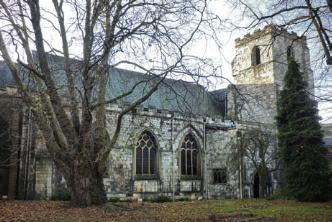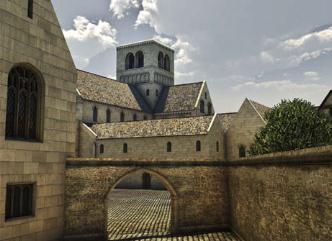

28
BCD Special Report on
Historic Churches
17th annual edition
One of the early anchors of the medieval
city of York was the Priory of the Holy Trinity
founded before the Conquest and standing
atop Bishop Hill beside Micklegate Bar, the
principal entry to the city. After the Conquest
it was re-founded and given to the Benedictine
Abbey of Marmoutier in France, thereby
making it an ‘alien’ house. Te church is listed
among the churches that sufered during the
great fre of 1137 and sometime in the later
12th century it seems to have undergone a long
campaign of rebuilding. During this period its
importance in the region was eclipsed by York’s
other Benedictine house, St Mary’s Abbey,
near the Minster, and it had a precarious and
colourful existence until the early 16th century.
As an institution it was a survivor,
evading two attempts at dissolution during
its fnal century. Te frst attempt was during
the suppression of the alien priories under
Henry V in 1414. Te monastery avoided
dissolution by petitioning the King, claiming
the undivided English loyalty of its inmates. In
1536 Henry VIII dissolved all monasteries with
an income of less than £200 per annum. Holy
Trinity was closed, but the monks were soon
restored to their stalls during the Pilgrimage
of Grace. Tis popular re-establishment
appears to have gone unnoticed by the Crown
after the collapse of the Pilgrimage and Holy
Trinity continued to function as a priory
until it was fnally dissolved in 1538 along
with a number of other houses in the city.
After the Dissolution the priory buildings
rapidly vanished, leaving the precinct site
virtually empty by 1610. But the priory church
itself remained, largely because it had served
as both monastic and parish church. In 1551,
however, the central tower collapsed in a storm.
Unable to aford repairs, the parishioners
abandoned the choir and transepts and
retreated into the nave where the aisle arcades
were blocked, the clerestory removed and
the west bay demolished reducing the church
to less than one third its original size. Tis
building, however, survives to the present
day and is still in use for parochial worship.
Creating the model
While the touchscreen installation is an
important part of the exhibition, allowing
visitors to intuitively understand over a century
of scholarship on the history and fabric of
the priory, the process of creating the virtual
reconstruction is equally valuable. More than
an opportunity to create a church ‘guidebook’
for the 21st century, the development of a
digital resource such as Holy Trinity’s is an
opportunity to bring together all of the previous
research pertaining to the site in order to push
understanding further through research driven
by the computer modelling process itself.
Computer modelling requires an attention
to detail unthinkable in other forms of
presentation. Te modeller must understand
not only the basic shape of the site in the
past, but also the materials used, colour and
decoration, efects of light and shadow, patterns
of usage and wear. What is presented in the
best three-dimensional reconstructions is
not simply a snapshot of a building, but a
comprehensive vision of the current state of
research on the site and the period depicted.
Equally important, a virtual reconstruction is
as valuable for the gaps in knowledge it reveals
as for the existing knowledge it presents.
Holy Trinity church itself remains standing
and, while shorn of every original outer wall,
the core of the nave and key exterior details are
preserved. Te 15th century parishioners built
their own bell tower atop the northwest bay
of the church thereby ‘fossilising’ the details
of that portion of the building and providing
adequate hints to later restorers to reconstruct
the appearance of the pre-Dissolution monastic
nave. Here, then, knowledge was most
complete and modelling was relatively simple.
Modelling became more problematic for
the remaining portions of the original church.
Tankfully, the site is littered with fragments
from the monastic choir and transepts from
which archaeologist David Stocker was able
to build a detailed architectural history. Tis
combined with the survey records of the early
20th century restorers allowed a reconstruction
of how the church east of the crossing may have
appeared in the mid 15th century when the
priory was in its heyday. Modelling the cloister
buildings was much more difcult. Only one
stone fragment from the cloister itself survives:
a double capital of the early 13th century. It is a
distinctive type and provided enough of a hint
to allow a full reconstruction of the cloister
arcades. Te cloister buildings themselves were
even more challenging as very little physical
or historical evidence survives. Based on clues
provided by property boundaries, old maps,
one surviving Romanesque doorway that
Te Church of the Holy Trinity, Micklegate, York. In 2009 the PCC approached Heritage Technology and the
University of York’s Centre for Christianity and Culture with a project centred on a digital reconstruction of the
church’s development from the late Middle Ages to the present.
Digital reconstruction of the Priory of the Holy Trinity. Te priory was one of the anchors of medieval York
but had virtually disappeared by 1610. Elements of the priory church survive as part of the Church of the Holy
Trinity, which remains in use for parochial worship. (Image: Geof Arnott/Heritage Technology)